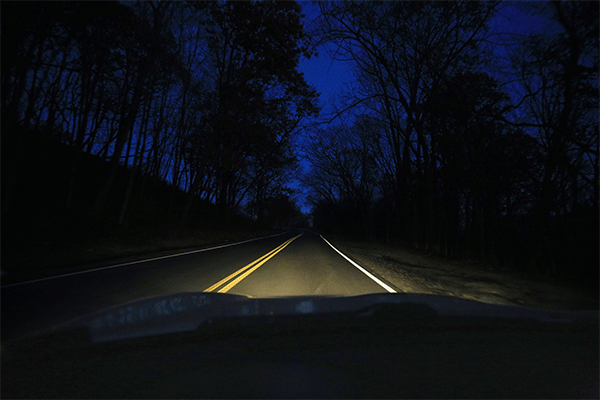Senior citizens face an interesting challenge when it comes to driving and safety. Though still wild at heart, the aging body may tell a different story. In addition to physical changes, driving has changed significantly in recent decades, and that can lead to unique and unforeseen complications.
Overall, older adults are relatively safe and conscientious drivers. However, for some, the physical changes of aging can interfere with driving responsibly. Senior drivers can compensate for the factors of aging that interfere with safe driving and adapt certain safe practices to prolong the ability to drive.
Driving Guidelines: How To Stay Safe As You Age
 The three primary areas of concern for seniors who drive are vision, hearing and response time. It’s also important to remember that you should always talk to your doctor about whether your medications will affect your driving ability. Though often overlooked, many medications can seriously impair judgment and reflexes.
The three primary areas of concern for seniors who drive are vision, hearing and response time. It’s also important to remember that you should always talk to your doctor about whether your medications will affect your driving ability. Though often overlooked, many medications can seriously impair judgment and reflexes.
Here are a few easy tips for staying safe when driving:
- Have your vision checked regularly, and keep the prescription current on any corrective lenses you may wear. It is also a good idea to keep your mirrors clean, change wiper blades often, turn up the lights on your control panel (usually by turning a small knob near the speedometer), and be sure to use defrost any time your windows begin to fog over.
- If hearing becomes an issue, check with your doctor and look into hearing aids if necessary. Keep music and other audible distractions to a minimum so that you are better able to hear horns and emergency vehicles approaching.
- With an increasing number of physical aid devices, limited mobility can now be accommodated in a variety of ways. Check with your doctor or an occupational therapist about options or modifications to your vehicle that could make driving easier for you while increasing your effectiveness on the road.
- Find a car that fits your needs. The latest developments in automobiles allow for a wide variety of options from power windows, locks and steering to seats that can “remember” your favorite driving position.
- Before heading out, plan your trip wisely and look for alternate routes. If you’re unsure of how to arrive at your destination, call for directions. For those of us who are technologically savvy, Global Positioning Devices (GPS) are a fun and easy way to do trip planning. Simply enter your destination and it will lead you there with step-by-step instructions.
- Don’t follow other vehicles too closely, especially at higher speeds. You want to make sure you have plenty of time to slow down in the event traffic comes to a sudden stop. By allowing a large distance between you and the car in front of you, you will have time to react to any number of situations safely and effectively.
- If you prefer to maintain a leisurely speed when traveling on high-speed roads, be courteous of the drivers around you by staying in the right lane.
- Enroll in a Defensive Driver program. These courses have a high success rate for attendees at increasing confidence, include tips on driving safely and can help lower your auto insurance rates. Not only are these courses educational, they can be fun, too!
Thoughts On Driving At Night

Regardless of age, driving at night presents a unique set of challenges. Avoiding an accident usually requires quick response times and sharp vision, both of which can be hindered by nighttime driving. Because safety is so important, we’ve compiled a list of items to help you avoid potential nighttime hazards.
- Keep your headlights, tail lights, windshield and side windows clean (inside and out). This will ensure you have an unobstructed view of your surroundings.
- When in doubt, drive with your lights on (in high traffic areas, only use your low-beams as a courtesy to other drivers). While having your lights on at twilight may not aid your ability to see, it will increase the likelihood that others can see you.
- It is more challenging to judge distances and speed in the dark so adjust your speed accordingly and allow for greater space between you and the car in front of you. Keep in mind, though, that driving too slow can also pose a danger.
- Falling asleep at the wheel is a leading cause of accidents. Never operate a vehicle if you’ve taken medication that causes drowsiness or fatigue. Take breaks often to help you remain awake and alert.
- If the headlights of oncoming vehicles are too bright or bother your eyes, remember to look down and to the right to help deflect the light. Using the right side of the road as a guide can help keep you on the road without jeopardizing your vision.
- It’s a good idea to have access to a cell phone in the event of an emergency. But avoid talking or using your phone while driving, especially at night. If you need to make a call or use your phone, find a safe place to pull over beforehand.
Defensive Driving Discounts
 You’ve probably heard about Defensive Driving courses, but may have wondered what the fuss is all about and what can it do for you. Not only are Defensive Driver classes fun and informative, they could save you money on your GEICO auto policy.* Here’s how:
You’ve probably heard about Defensive Driving courses, but may have wondered what the fuss is all about and what can it do for you. Not only are Defensive Driver classes fun and informative, they could save you money on your GEICO auto policy.* Here’s how:
- According to the Insurance Institute for Highway Safety (IIHS), fatal crash rates per miles traveled increase noticeably starting at age 70-74 and are highest among drivers 85 and older. Defensive Driver/Driver Safety programs are not only a refresher on safe driving, but it can help us avoid accidents in the first place. And we all know that avoiding accidents is the best way to keep our insurance rates low.
- The purpose of these programs is to train drivers in collision prevention techniques. There are countless options for taking a Defensive Driver course, from comedy schools to online training to social-like gatherings where you learn the basics of safety and prevention while enjoying a friendly environment.
- According to AARP, self-reports by program participants have indicated behavior change, with four out of five graduates reporting that they adjusted their driving behavior as a result of taking the class.
- GEICO offers a substantial discount to policyholders who successfully complete a Defensive Driver class and meet certain requirements (for example: most states require that you be at least 50 years young before the discount can be applied). For more details, visit our state information pages or give us a call.
Whether you enjoy the freedom of the open road or simply drive around town for weekly errands, it’s important to remember that certain adjustments need to be made in order to accommodate changing physical abilities. With a few simple changes, it is easy to increase your chances of staying safe and alert.
By Dawn McCaslin
* Defensive Driver discount is available in most states, so be sure to contact us for more information on regulations for your state.









Jane Nelson says,
I was told I could take the defensive driving course online. I am finding no link to it.
Editor says,
Here is the link: https://www.geico.com/save/discounts/defensive-driver-discounts/
Cynthia Marker says,
Does GIECO have discounts for people 65 and older?
Editor says,
Hi! You can check out all of our discounts, including those for defensive driving courses here: https://www.geico.com/save/discounts/car-insurance-discounts/
Rosemarie A. Drygala says,
Looking for options for a defensive driving course any recommendations .
Editor says,
Here is info on defensive driving courses by state: https://www.geico.com/save/discounts/defensive-driver-discounts/
Joseph Tomlinson says,
I wish to enroll in a senior citzen driving course which I understand you offer. I do not see a place on your web site to sign up. I need it by August.
Joseph Tomlinson
Editor says,
https://www.geico.com/save/discounts/defensive-driver-discounts/
Joseph E. and Judith B. Tirpak says,
Thank you for the tips provided to us as senior drivers. We found it very helpful.
We both completed a senior driving course some time ago, (over 10 Years ago?)
What kind of course should we pursue and with what organization in our area?
Editor says,
You can find information on defensive driver courses by state here: https://www.geico.com/save/discounts/defensive-driver-discounts/
Joyce M Wooten says,
I laughed when I saw the cow sign,etc. I’ve never seen most of those since I never travel outside of my area.
David Callahan says,
Thanks for your quiz. Yes, I have taken your Driver Safety class for Seniors. Thanks again!
Joannie says,
How much discount do you get from Geico if hi take course
Editor says,
For more details, please visit our state information pages:
https://www.geico.com/save/discounts/defensive-driver-discounts/
Bill Dore says,
Very true as we age out reaction also slows down, after all we should not follow to close to the car in front of you.
Also when the traffic turn yellow stop do not try to speed through it we’re retired and there is no need to rush…
Rachelle Reeves says,
I agree that when in doubt, you should drive with your lights on. It doesn’t hurt anyone is your lights are on during the day, but it definitely can hurt someone if they are off at night. What is the oldest age a senior can drive?